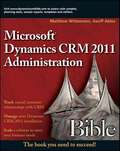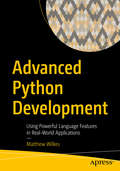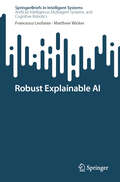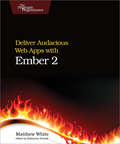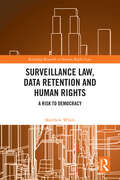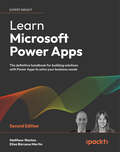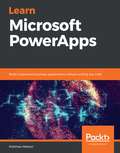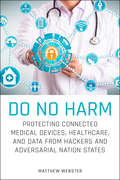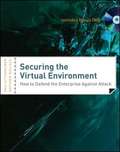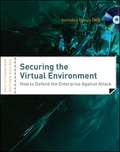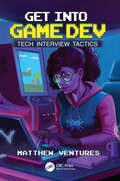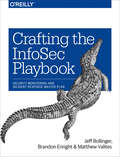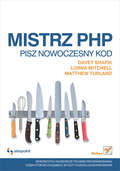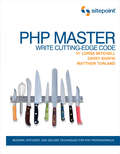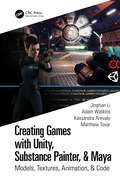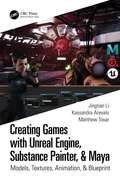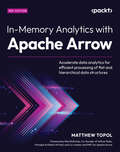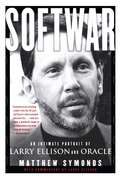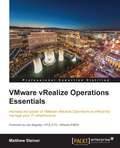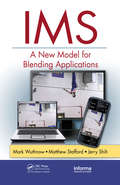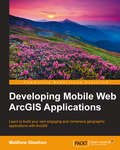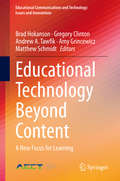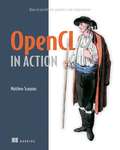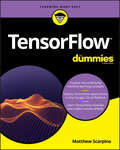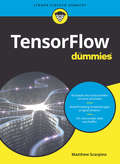- Table View
- List View
Microsoft Dynamics CRM 2011 Administration Bible
by Matthew Wittemann Geoff AblesAn in-depth, expert guide to Microsoft Dynamics CRM 2011 from Microsoft CRM experts! What better way to learn how to administer Dynamics CRM 2011 than from two Microsoft CRM experts? This in-depth Bible is packed with expert guidance on the latest version of Microsoft's hot CRM product. Whether you're new to Dynamics CRM or upgrading from an earlier version, you'll get thoroughly up to speed on everything from the basics to new features and more. Brings you up to speed on Microsoft Dynamics CRM 2011, the latest version of Microsoft's fast-growing customer relationship management software Shows you how to get the most out of the application, including configuration and customization, integrating with Microsoft Office, and automating business processes Features step-by-step instruction and in-depth coverage of all essential topics; you'll want to keep this information-packed book at your desk as a practical reference If you want to master Microsoft Dynamics CRM 2011 for your business contacts, this is the book you need to succeed
Advanced Python Development: Using Powerful Language Features in Real-World Applications
by Matthew WilkesThis book builds on basic Python tutorials to explain various Python language features that aren’t routinely covered: from reusable console scripts that play double duty as micro-services by leveraging entry points, to using asyncio efficiently to collate data from a large number of sources. Along the way, it covers type-hint based linting, low-overhead testing and other automated quality checking to demonstrate a robust real-world development process.Some powerful aspects of Python are often documented with contrived examples that explain the feature as a standalone example only. By following the design and build of a real-world application example from prototype to production quality you'll see not only how the various pieces of functionality work but how they integrate as part of the larger system design process. In addition, you'll benefit from the kind of useful asides and library recommendations that are a staple of conference Q&A sessions at Python conferences as well as discussions of modern Python best practice and techniques to better produce clear code that is easily maintainable.Advanced Python Development is intended for developers who can already write simple programs in Python and want to understand when it’s appropriate to use new and advanced language features and to do so in a confident manner. It is especially of use to developers looking to progress to a more senior level and to very experienced developers who have thus far used older versions of Python.What You'll Learn Understand asynchronous programmingExamine developing plugin architecturesWork with type annotationsReview testing techniquesExplore packaging and dependency managementWho This Book Is ForDevelopers at the mid to senior level who already have Python experience.
Robust Explainable AI (SpringerBriefs in Intelligent Systems)
by Francesco Leofante Matthew WickerThe area of Explainable Artificial Intelligence (XAI) is concerned with providing methods and tools to improve the interpretability of black-box learning models. While several approaches exist to generate explanations, they are often lacking robustness, e.g., they may produce completely different explanations for similar events. This phenomenon has troubling implications, as lack of robustness indicates that explanations are not capturing the underlying decision-making process of a model and thus cannot be trusted. This book aims at introducing Robust Explainable AI, a rapidly growing field whose focus is to ensure that explanations for machine learning models adhere to the highest robustness standards. We will introduce the most important concepts, methodologies, and results in the field, with a particular focus on techniques developed for feature attribution methods and counterfactual explanations for deep neural networks. As prerequisites, a certain familiarity with neural networks and approaches within XAI is desirable but not mandatory. The book is designed to be self-contained, and relevant concepts will be introduced when needed, together with examples to ensure a successful learning experience.
Deliver Audacious Web Apps with Ember 2
by Matthew WhiteIt's time for web development to be fun again, time to write engaging and attractive apps--fast--in this brisk tutorial. Build a complete user interface in a few lines of code, create reusable web components, access RESTful services and cache the results for performance, and use JavaScript modules to bring abstraction to your code. Find out how you can get your crucial app infrastructure up and running quickly, so you can spend your time on the stuff great apps are made of: features.With its 2.0 release, the Ember JavaScript framework has taken a major step forward. In this book, you'll learn these new features: how to use module-driven development with Ember CLI, take advantage of the new DOM-based rendering engine, and use a service-based architecture to make your apps flexible, not brittle.Use the Ember CLI to build your app using module-focused JavaScript classes with a clear project structure. Learn how to use Ember's routing classes to organize your app, write web components that marry your user interface and logic without leaky access to state, and read and write data from RESTful services with almost no code. Make use of services to encapsulate logic and inject it throughout your app, and use Ember CLI to rapidly iterate changes, deploy locally, test your code, and build for production. You'll learn all the essentials of working with Ember.If you're tired of feeling limited by your web development tools, unleash your ambition and start creating ambitious web applications with Ember.What You Need:You need Ember, Ember CLI, Google Chrome or Mozilla Firefox, and a text editor.
Surveillance Law, Data Retention and Human Rights: A Risk to Democracy (Routledge Research in Human Rights Law)
by Matthew WhiteThis book analyses the compatibility of data retention in the UK with the European Convention on Human Rights (ECHR). The increase in the use of modern technology has led to an explosion of generated data and, with that, a greater interest from law enforcement and intelligence agencies. In the early 2000s, data retention laws were introduced into the UK, and across the European Union (EU). This was met by domestic challenges before national courts, until a seminal ruling by the Court of Justice in the European Union (CJEU) ruled that indiscriminate data retention was incompatible with EU law. Since then, however, the CJEU has revised its position and made certain concessions, particularly under the guise of national security. This book focuses on data retention in the UK with the principal aim of examining compatibility with the ECHR. This is explored through a variety of ways including providing an account of democracy and why secret surveillance poses a threat to it, a history of data retention, assessing the seriousness that data retention poses to fundamental rights, the collection of rights that are affected by data retention which are crucial for a functioning democracy, the implications of who can be obligated to retain (and what to retain), the idea that data retention is a form of surveillance and ultimately, with all things considered, whether this is compatible with the ECHR. The work will be an invaluable resource for students, academics, researchers and policy-makers working in the areas of privacy, human rights law and surveillance.
Learn Microsoft Power Apps: The definitive handbook for building solutions with Power Apps to solve your business needs
by Matthew Weston Elisa Bárcena MartínA step-by-step guide that will help you create, share, and deploy applications across your organization using Microsoft Power Apps Purchase of the print or Kindle book includes a free PDF eBookKey FeaturesBuild apps from scratch to solve real-world business scenarios Learn how to keep app data secure with expanded coverage on DataverseIncorporate AI into your app building process using AI Builder and CopilotBook DescriptionMicrosoft Power Apps provides a modern approach to building low-code business applications for mobiles, tablets, browsers, and Microsoft Teams. The second edition of Learn Microsoft Power Apps will guide you in creating well designed and secure apps that transform old processes and workflows. Learn Microsoft Power Apps starts with an introduction to Power Apps to help you feel comfortable with the creation experience. Using screenshots from the latest UI, you will be guided through how to create an app, building your confidence to start developing further. This book will help you design, set up, and configure your first application by writing simple formulas. You'll learn about the different types of apps you can build in Power Apps and which one applies best to your requirements. In addition to this, you’ll learn how to identify the right data storage system for you, with new chapters covering how to integrate apps with SharePoint or Dataverse. As you advance, you’ll be able to use various controls, connectors, and data sources to create a powerful, interactive app. For example, this book will help you understand how Power Apps can use Microsoft Power Automate, Power BI, and Azure functionalities to improve your applications. Finally, you will be introduced to the emerging Power Apps Copilot tool, which uses artificial intelligence to accelerate the app building process. By the end of this Power Apps book, you’ll be ready to confidently develop lightweight business applications with minimal code.What you will learnUnderstand the Power Apps ecosystem and licensingTake your first steps building canvas appsDevelop apps using intermediate techniques such as the barcode scanner and GPS controlsExplore new connectors to integrate tools across the Power PlatformStore data in Dataverse using model-driven appsDiscover the best practices for building apps cleanly and effectivelyUse AI for app development with AI Builder and CopilotWho this book is forThis book is intended for business analysts, IT professionals, and both developers and non-developers alike. If you want to meet business needs by creating purpose-built apps, this book is for you. To get the most out of this book, it is recommended that you have a basic understanding of Microsoft 365 as you will interact with various elements of it while developing apps.
Learn Microsoft PowerApps: Build customized business applications without writing any code
by Matthew WestonThis book is for Developers, non-developers and any IT professional who wants to learn Microsoft PowerApps to either start developing or want to expand their knowledge of development in PowerApps.
Do No Harm: Protecting Connected Medical Devices, Healthcare, and Data from Hackers and Adversarial Nation States
by Matthew WebsterDiscover the security risks that accompany the widespread adoption of new medical devices and how to mitigate them In Do No Harm: Protecting Connected Medical Devices, Healthcare, and Data from Hackers and Adversarial Nation States, cybersecurity expert Matthew Webster delivers an insightful synthesis of the health benefits of the Internet of Medical Things (IoMT), the evolution of security risks that have accompanied the growth of those devices, and practical steps we can take to protect ourselves, our data, and our hospitals from harm. You’ll learn how the high barriers to entry for innovation in the field of healthcare are impeding necessary change and how innovation accessibility must be balanced against regulatory compliance and privacy to ensure safety. In this important book, the author describes: The increasing expansion of medical devices and the dark side of the high demand for medical devices The medical device regulatory landscape and the dilemmas hospitals find themselves in with respect medical devices Practical steps that individuals and businesses can take to encourage the adoption of safe and helpful medical devices or mitigate the risk of having insecure medical devices How to help individuals determine the difference between protected health information and the information from health devices--and protecting your data How to protect your health information from cell phones and applications that may push the boundaries of personal privacy Why cybercriminals can act with relative impunity against hospitals and other organizations Perfect for healthcare professionals, system administrators, and medical device researchers and developers, Do No Harm is an indispensable resource for anyone interested in the intersection of patient privacy, cybersecurity, and the world of Internet of Medical Things.
Securing the Virtual Environment
by Davi Ottenheimer Matthew WallaceA step-by-step guide to identifying and defending against attacks on the virtual environmentAs more and more data is moved into virtual environments the need to secure them becomes increasingly important. Useful for service providers as well as enterprise and small business IT professionals the book offers a broad look across virtualization used in various industries as well as a narrow view of vulnerabilities unique to virtual environments. A companion DVD is included with recipes and testing scripts.Examines the difference in a virtual model versus traditional computing models and the appropriate technology and procedures to defend it from attack Dissects and exposes attacks targeted at the virtual environment and the steps necessary for defense Covers information security in virtual environments: building a virtual attack lab, finding leaks, getting a side-channel, denying or compromising services, abusing the hypervisor, forcing an interception, and spreading infestationsAccompanying DVD includes hands-on examples and codeThis how-to guide arms IT managers, vendors, and architects of virtual environments with the tools they need to protect against common threats.
Securing the Virtual Environment: How to Defend the Enterprise Against Attack
by Davi Ottenheimer Matthew WallaceA step-by-step guide to identifying and defending against attacks on the virtual environment As more and more data is moved into virtual environments the need to secure them becomes increasingly important. Useful for service providers as well as enterprise and small business IT professionals the book offers a broad look across virtualization used in various industries as well as a narrow view of vulnerabilities unique to virtual environments. A companion DVD is included with recipes and testing scripts. Examines the difference in a virtual model versus traditional computing models and the appropriate technology and procedures to defend it from attack Dissects and exposes attacks targeted at the virtual environment and the steps necessary for defense Covers information security in virtual environments: building a virtual attack lab, finding leaks, getting a side-channel, denying or compromising services, abusing the hypervisor, forcing an interception, and spreading infestations Accompanying DVD includes hands-on examples and code This how-to guide arms IT managers, vendors, and architects of virtual environments with the tools they need to protect against common threats.
Get Into Game Dev: Tech Interview Tactics
by Matthew VenturesGet Into Game Dev: Tech Interview Tactics is a crash-course on how to pass a game development technical interview. It’s designed to guide intermediate and experienced coders through the depth and rigor necessary to land some of the most highly sought-after roles within interactive media.Unlike generic interview-prep books, GIGD maintains a laser-focus on game development to directly prepare candidates for roles like technical designer and gameplay engineer. Topics include 3D maths, programming fundamentals, and software design patterns. The author provides high quality instruction and practice problems based on his experience as a professional instructor and developer.Key Features: Includes an extensive set of practice questions taken from interviews of leading game development studios. Synthesizes coding and maths fundamentals into focused instruction, directly applicable to game development. Culminates in a rigorous practice test, designed to identify a reader’s weaknesses and guide them along the path to mastery. Uses a variety of mnemonics to assist readers in memorizing subject matter. Provides example worked solutions for readers to compare against their own problem-solving approaches. This book does not teach game development. Instead, it provides knowledge and instruction for a developer to achieve the technical mastery necessary to become a professional game developer.
Crafting the InfoSec Playbook: Security Monitoring and Incident Response Master Plan
by Matthew Valites Brandon Enright Jeff BollingerAny good attacker will tell you that expensive security monitoring and prevention tools aren’t enough to keep you secure. This practical book demonstrates a data-centric approach to distilling complex security monitoring, incident response, and threat analysis ideas into their most basic elements. You’ll learn how to develop your own threat intelligence and incident detection strategy, rather than depend on security tools alone.Written by members of Cisco’s Computer Security Incident Response Team, this book shows IT and information security professionals how to create an InfoSec playbook by developing strategy, technique, and architecture.Learn incident response fundamentals—and the importance of getting back to basicsUnderstand threats you face and what you should be protectingCollect, mine, organize, and analyze as many relevant data sources as possibleBuild your own playbook of repeatable methods for security monitoring and responseLearn how to put your plan into action and keep it running smoothlySelect the right monitoring and detection tools for your environmentDevelop queries to help you sort through data and create valuable reportsKnow what actions to take during the incident response phase
Mistrz PHP. Pisz nowoczesny kod
by Davey Shafik Lorna Mitchell Matthew TurlandWykorzystaj najnowsze techniki programowania, dzi?ki którym osi?gniesz wy?szy poziom zaawansowania"Mistrz PHP. Pisz nowoczesny kod" to ksi??ka przeznaczona dla programistów PHP, którzy znaj? ju? podstawy tego j?zyka i chc? rozwin?? swoje umiej?tno?ci, by tworzy? bardziej zaawansowane rozwi?zania. Znajdziesz w niej cenne rady, jak udoskonali? swoje aplikacje serwerowe, oraz wszystko, czego potrzeba do stosowania najefektywniejszych technik obiektowych, zabezpieczania kodu czy pisania programów idealnie spe?niaj?cych swoje zadania. W ka?dym rozdziale poznasz nowe sposoby wykonywania pewnych zada? oraz nowe teorie, le??ce u pod?o?a stosowanych przez Ciebie technik. Dzi?ki lekturze tej publikacji przemienisz si? ze sprawnego programisty w pewnego siebie in?yniera - stosuj?cego najlepsze praktyki programistyczne, pracuj?cego szybko i solidnie. Autorzy przedstawiaj? praktyczne problemy i u?yteczne rozwi?zania, które zaprowadz? Ci? na szczyt kariery! Je?li szukasz mo?liwo?ci scementowania ca?ej swojej wiedzy i chcesz zdoby? solidne podstawy, ta ksi??ka jest dla Ciebie.Dowiesz si? z niej, jak:tworzy? profesjonalne dynamiczne aplikacje w oparciu o obiektowe wzorce programowaniau?ywa? zaawansowanych narz?dzi do oceny wydajno?ci programów, aby zmaksymalizowa? ich mo?liwo?cistosowa? nowoczesne techniki testowania, pozwalaj?ce uzyska? niezawodny kodzabezpiecza? programy przed atakami zewn?trznymi przy u?yciu najskuteczniejszych techniku?ywa? funkcji dost?pnych w bibliotekach i interfejsach programistycznych j?zyka PHP…i wiele wi?cejPraktyczne problemy i u?yteczne rozwi?zania, które zaprowadz? Ci? na szczyt kariery!
PHP Master: Write Cutting Edge Code
by Davey Shafik Lorna Mitchell Matthew TurlandPHP Master is tailor-made for the PHP developer who's serious about taking their server-side applications to the next level and who wants to really keep ahead of the game by adhering to best practice, employing the most effective object-oriented programming techniques, wrapping projects in layers of security and ensuring their code is doing its job perfectly.Create professional, dynamic applications according to an object-oriented programming blueprintLearn advanced performance evaluation techniques for maximum site efficiencyBrush up on the best testing methods to refine your code and keep your applications watertightProtect your site against attacks and vulnerabilities with the latest security systemsPlug in to some serious functionality with PHP's APIs and libraries
Creating Games with Unity, Substance Painter, & Maya: Models, Textures, Animation, & Code
by Adam Watkins Jingtian Li Kassandra Arevalo Matthew TovarThis tutorial-based book allows readers to create a first-person game from start to finish using industry-standard (and free to student) tools of Unity, Substance Painter, and Maya. The first half of the book lays out the basics of using Maya and Substance Painter to create game-ready assets. This includes polygonal modeling, UV layout, and custom texture painting. The book then covers rigging and animation solutions to create assets to be placed in the game, including animated first-person assets and motion-captured NPC animations. Finally, readers can put it all together and build interactivity that allows the player to create a finished game using the assets built and animated earlier in the book. • Written by industry professionals with real-world experience in building assets and games • Build a complete game from start to finish • Learn what the pros use: construct all assets using the tools used at game studios across the world • All software used are free to students • When complete, students will have a playable version of an FPS game Jingtian Li is a graduate of China’s Central Academy of Fine Arts and New York’s School of Visual Arts, where he earned an MFA in Computer Art. He currently is an Assistant Professor of 3D Animation & Game Design at the University of the Incarnate Word in San Antonio, Texas. Adam Watkins is a 20-year veteran of 3D education. He holds an MFA in 3D Animation and a BFA in Theatre Arts from Utah State University. He currently is the Coordinator and Professor of the 3D Animation & Game Department at the University of the Incarnate Word in San Antonio, Texas. Kassandra Arevalo is an instructor of 3D Animation & Game Design at the University of the Incarnate Word in San Antonio, Texas. She previously worked as an animator at Immersed Games. Matt Tovar is an industry veteran animator. He has worked at Naughty Dog, Infinity Ward, and Sony Interactive on such games as The Last of Us, Call of Duty: Modern Warfare, and most recently Marvel’s Avengers with Crystal Dynamics. He is an Assistant Professor of 3D Animation at the University of the Incarnate Word in San Antonio, Texas.
Creating Games with Unreal Engine, Substance Painter, & Maya: Models, Textures, Animation, & Blueprint
by Jingtian Li Kassandra Arevalo Matthew TovarDescription: This tutorial-based book allows readers to create a first-person game from start to finish using industry-standard (and free to student) tools of Maya, Substance Painter, and Unreal Engine. The first half of the book lays out the basics of using Maya and Substance Painter to create game-ready assets. This includes polygonal modeling, UV layout, and custom texture painting. Then, the book covers rigging and animation solutions to create assets to be placed in the game including animated first-person assets and motion-captured NPC animations. Finally, readers can put it all together and build interactivity that allows the player to create a finished game using the assets built and animated earlier in the book. • Written by industry professionals with real-world experience in building assets and games. • Build a complete game from start to finish. • Learn what the pros use: construct all assets using the tools used at industries across the world. • All software used are free to students. • When complete, students will have a playable version of an FPS game. Jing Tian Li is a graduate of China’s Central Academy of Fine Arts and New York’s School of Visual Arts, where he earned an MFA in Computer Art. He currently is an Assistant Professor of 3D Animation & Game Design at the University of the Incarnate Word in San Antonio, Texas. Kassandra Arevalo is an instructor of 3D Animation & Game Design at the University of the Incarnate Word in San Antonio, Texas. She previously worked as an animator at Immersed Games. Matt Tovar is an industry veteran animator. He has worked at Naughty Dog, Infinity Ward, and Sony Interactive on such games as The Last of Us, Call of Duty: Modern Warfare, and most recently Marvel’s Avengers with Crystal Dynamics. He is an Assistant Professor of 3D Animation at the University of the Incarnate Word in San Antonio, Texas.
In-Memory Analytics with Apache Arrow: Accelerate data analytics for efficient processing of flat and hierarchical data structures
by Matthew TopolHarness the power of Apache Arrow to optimize tabular data processing and develop robust, high-performance data systems with its standardized, language-independent columnar memory formatKey FeaturesExplore Apache Arrow's data types and integration with pandas, Polars, and ParquetWork with Arrow libraries such as Flight SQL, Acero compute engine, and Dataset APIs for tabular dataEnhance and accelerate machine learning data pipelines using Apache Arrow and its subprojectsPurchase of the print or Kindle book includes a free PDF eBookBook DescriptionApache Arrow is an open source, columnar in-memory data format designed for efficient data processing and analytics. This book harnesses the author’s 15 years of experience to show you a standardized way to work with tabular data across various programming languages and environments, enabling high-performance data processing and exchange. This updated second edition gives you an overview of the Arrow format, highlighting its versatility and benefits through real-world use cases. It guides you through enhancing data science workflows, optimizing performance with Apache Parquet and Spark, and ensuring seamless data translation. You’ll explore data interchange and storage formats, and Arrow's relationships with Parquet, Protocol Buffers, FlatBuffers, JSON, and CSV. You’ll also discover Apache Arrow subprojects, including Flight, SQL, Database Connectivity, and nanoarrow. You’ll learn to streamline machine learning workflows, use Arrow Dataset APIs, and integrate with popular analytical data systems such as Snowflake, Dremio, and DuckDB. The latter chapters provide real-world examples and case studies of products powered by Apache Arrow, providing practical insights into its applications. By the end of this book, you’ll have all the building blocks to create efficient and powerful analytical services and utilities with Apache Arrow.What you will learnUse Apache Arrow libraries to access data files, both locally and in the cloudUnderstand the zero-copy elements of the Apache Arrow formatImprove the read performance of data pipelines by memory-mapping Arrow filesProduce and consume Apache Arrow data efficiently by sharing memory with the C APILeverage the Arrow compute engine, Acero, to perform complex operationsCreate Arrow Flight servers and clients for transferring data quicklyBuild the Arrow libraries locally and contribute to the communityWho this book is forThis book is for developers, data engineers, and data scientists looking to explore the capabilities of Apache Arrow from the ground up. Whether you’re building utilities for data analytics and query engines, or building full pipelines with tabular data, this book can help you out regardless of your preferred programming language. A basic understanding of data analysis concepts is needed, but not necessary. Code examples are provided using C++, Python, and Go throughout the book.
Softwar: An Intimate Portrait of Larry Ellison and Oracle
by Matthew SymondsIn a business where great risks, huge fortunes, and even bigger egos are common, Larry Ellison stands out as one of the most outspoken, driven, and daring leaders of the software industry. The company he cofounded and runs, Oracle, is the number one business software company: perhaps even more than Microsoft's, Oracle's products are essential to today's networked world.But Oracle is as controversial as it is influential, as feared as it is revered, thanks in large part to Larry Ellison. Though Oracle is one of the world's most valuable and profitable companies, Ellison is not afraid to suddenly change course and reinvent Oracle in the pursuit of new and ever more ambitious goals. Softwar examines the results of these shifts in strategy and the forces that drive Ellison relentlessly on.In Softwar, journalist Matthew Symonds gives readers an exclusive and intimate insight into both Oracle and the man who made it and runs it. As well as relating the story of Oracle's often bumpy path to industry dominance, Symonds deals with the private side of Ellison's life. From Ellison's troubled upbringing by adoptive parents and his lifelong search for emotional security to the challenges and opportunities that have come with unimaginable wealth, Softwar gets inside the skin of a fascinating and complicated human being. With unlimited insider access granted by Ellison himself, Symonds captures the intensity and, some would say, the recklessness that have made Ellison a legend.The result of more than a hundred hours of interviews and many months spent with Ellison, Softwar is the most complete portrait undertaken of the man and his empire -- a unique and gripping account of both the way the computing industry really works and an extraordinary life.Despite his closeness to Ellison, Matthew Symonds is a candid and at times highly critical observer. And in perhaps the book's most unusual feature, Ellison responds to Symonds's portrayal in the form of a running footnoted commentary.The result is one of the most fascinating business stories of all time.
VMware vRealize Operations Essentials
by Matthew SteinerHarness the power of VMware vRealize Operations to efficiently manage your IT infrastructure About This Book * Extract the optimum performance, availability, and capacity of your IT infrastructure with the help of vRealise Operations Manager * Leverage the power of strategic reports to drive tactful decision-making within the IT department * A pragmatic guide to proficiently manage your applications and storage Who This Book Is For If you are a vSphere administrator and wish to optimize your virtual environment, this book is your go-to guide on vRealize Operations. As a vSphere administrator, it is assumed that you have a good understanding of both physical and virtual infrastructure. A basic knowledge of application monitoring and log analysis would be useful when we dive into the capabilities of the solution. What You Will Learn * Architect, design, and install vRealize Operations * Migrate from the previous vCenter Operations Manager 5.x version, configure vR Ops policies, and create custom groups * Use out-of-the-box Dashboards, Views, and Reports and create your own customized Dashboards, Views, and Reports * Apply the Alerting framework of Symptoms, Recommendations, and Actions, and create your own Alerting content * Leverage the power of Capacity Planning to maximize the utilization of your virtual infrastructure * Manage the rest of your infrastructure, including storage and applications, with vRealize Operations Management Packs * Extend the solution with vRealize Hyperic and Log Insight In Detail This book will enable you to deliver on the operational disciplines of Performance, Health, Capacity, Configuration, and Compliance by making the best use of solutions provided by vRealize Operations. Starting with architecture, design, and sizing, we will ensure your implementation of vRealize Operations is a success. We will dive into the utilization of a solution to manage your vSphere infrastructure. Then, we will employ out-of-the-box Dashboards and the very powerful Views and Reporting functionality of vRealize Operations to create your custom dashboards and address your reporting requirements. Next, we go through the Alerting framework and how Symptoms, Recommendations, and Actions are used to achieve efficient operations. Later you will master the topic of Capacity Planning, where we look at how important it is to craft appropriate policies to match your requirements, and we'll consider attitude toward capacity risk, which will aid you to build future project requirements into your capacity plans. Finally, we will look at extending the solution to manage Storage, Applications, and other IT infrastructures using Management Packs from Solution Exchange, as well as how the solution can be enhanced with the integration of Log Insight. Style and approach This book is a pragmatic, step-by-step guide that will quickly build your knowledge of the key capabilities of vRealize Operations. As well as learning about the solution, we will provide you with real-world examples that will help you customize and enhance your virtual environment.
IMS: A New Model for Blending Applications
by Matthew Stafford Mark Wuthnow Jerry ShihIP Multimedia Subsystem (IMS) technology, which merges the Internet with interactive telecommunications, represents the here and now for today's packet-switched networks. Consequently, anyone working with or around these converging fields needs to possess a fundamental understanding of IMS and how this technology is poised to change the way new app
Developing Mobile Web ArcGIS Applications
by Matthew SheehanThis guide is invaluable to those just starting out with GIS development but will also benefit GIS professionals wishing to expand their development skills to include mobile apps.
Educational Technology Beyond Content: A New Focus for Learning (Educational Communications and Technology: Issues and Innovations)
by Brad Hokanson Gregory Clinton Andrew A. Tawfik Amy Grincewicz Matthew SchmidtThis book is the outcome of a research symposium sponsored by the Association for Educational Communications and Technology [AECT]. Consisting of twenty-four chapters, including an introduction and conclusion, it argues that informational content should not be the main element of education, and that to provide more for learners, it is necessary to go beyond content and address other skills and capabilities. It also discusses the false premise that learning is complete when the information is known, not when learners seek more: their own directions, answers, and ideas. The authors assert that the ability to synthesize, solve problems and generate ideas is not based on specific content, although education often focuses solely on teaching content. Further, they state that content can be separated from the learning process and that instructional design and educational technology must be about the skills, habits, and beliefs to be learned.
OpenCL in Action: How to accelerate graphics and computations
by Matthew ScarpinoSummaryOpenCL in Action is a thorough, hands-on presentation of OpenCL, with an eye toward showing developers how to build high-performance applications of their own. It begins by presenting the core concepts behind OpenCL, including vector computing, parallel programming, and multi-threaded operations, and then guides you step-by-step from simple data structures to complex functions.About the TechnologyWhatever system you have, it probably has more raw processing power than you're using. OpenCL is a high-performance programming language that maximizes computational power by executing on CPUs, graphics processors, and other number-crunching devices. It's perfect for speed-sensitive tasks like vector computing, matrix operations, and graphics acceleration.About this BookOpenCL in Action blends the theory of parallel computing with the practical reality of building high-performance applications using OpenCL. It first guides you through the fundamental data structures in an intuitive manner. Then, it explains techniques for high-speed sorting, image processing, matrix operations, and fast Fourier transform. The book concludes with a deep look at the all-important subject of graphics acceleration. Numerous challenging examples give you different ways to experiment with working code.A background in C or C++ is helpful, but no prior exposure to OpenCL is needed. Purchase of the print book comes with an offer of a free PDF, ePub, and Kindle eBook from Manning. Also available is all code from the book. What's InsideLearn OpenCL step by stepTons of annotated codeTested algorithms for maximum performance***********Table of ContentsPART 1 FOUNDATIONS OF OPENCL PROGRAMMINGIntroducing OpenCLHost programming: fundamental data structuresHost programming: data transfer and partitioningKernel programming: data types and device memoryKernel programming: operators and functionsImage processingEvents, profiling, and synchronizationDevelopment with C++ Development with Java and PythonGeneral coding principlesPART 2 CODING PRACTICAL ALGORITHMS IN OPENCLReduction and sortingMatrices and QR decompositionSparse matricesSignal processing and the fast Fourier transformPART 3 ACCELERATING OPENGL WITH OPENCLCombining OpenCL and OpenGLTextures and renderbuffers
TensorFlow For Dummies
by Matthew ScarpinoBecome a machine learning pro! Google TensorFlow has become the darling of financial firms and research organizations, but the technology can be intimidating and the learning curve is steep. Luckily, TensorFlow For Dummies is here to offer you a friendly, easy-to-follow book on the subject. Inside, you’ll find out how to write applications with TensorFlow, while also grasping the concepts underlying machine learning—all without ever losing your cool! Machine learning has become ubiquitous in modern society, and its applications include language translation, robotics, handwriting analysis, financial prediction, and image recognition. TensorFlow is Google's preeminent toolset for machine learning, and this hands-on guide makes it easy to understand, even for those without a background in artificial intelligence. Install TensorFlow on your computer Learn the fundamentals of statistical regression and neural networks Visualize the machine learning process with TensorBoard Perform image recognition with convolutional neural networks (CNNs) Analyze sequential data with recurrent neural networks (RNNs) Execute TensorFlow on mobile devices and the Google Cloud Platform (GCP) If you’re a manager or software developer looking to use TensorFlow for machine learning, this is the book you’ll want to have close by.
TensorFlow für Dummies (Für Dummies)
by Matthew ScarpinoTensorFlow ist Googles herausragendes Werkzeug für das maschinelle Lernen, und dieses Buch macht es zugänglich, selbst wenn Sie bisher wenig über neuronale Netze und Deep Learning wissen. Sie erfahren, auf welchen Prinzipien TensorFlow basiert und wie Sie mit TensorFlow Anwendungen 1.0 schreiben. Gleichzeitig lernen Sie die Konzepte des maschinellen Lernens kennen. Wenn Sie Softwareentwickler sind und TensorFlow in Zukunft einsetzen möchten, dann ist dieses Buch der richtige Einstieg für Sie. Greifen Sie auch zu, wenn Sie einfach mehr über das maschinelle Lernen erfahren wollen.
